More nursing homes could go on strike -
Added on 2022-08-21
39 Pages13915 Words22 Views
Running head: NURSING CARE
Nursing Care Post Leg-Amputation in Diabetic Patients
Name of the Student
Name of the University
Author Note
Nursing Care Post Leg-Amputation in Diabetic Patients
Name of the Student
Name of the University
Author Note

NURSING CARE 1
Acknowledgement
Acknowledgement
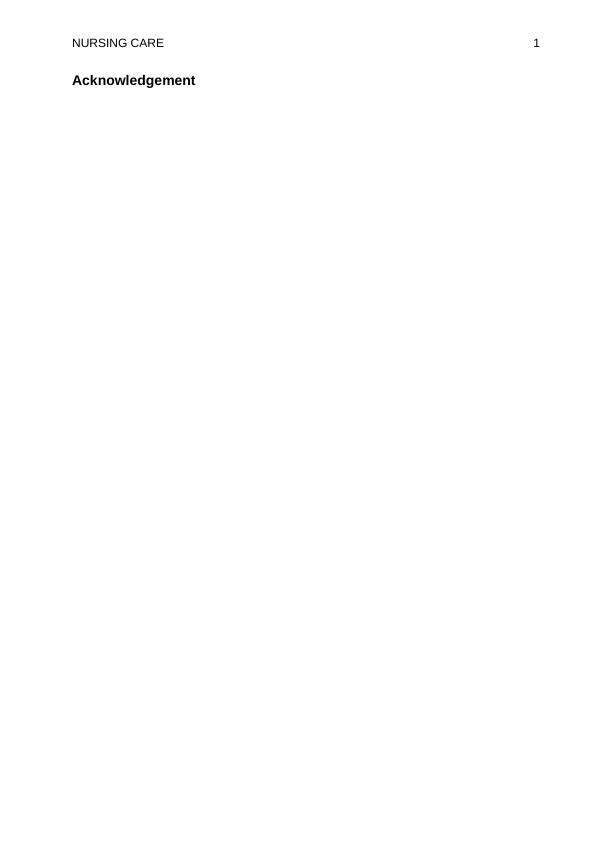
NURSING CARE 2
Abstract
Aim: The following study aims to conduct an extended review of the literature to
explore the perception of diabetic patients who have recently undergone leg
amputation due to severe complication of diabetic foot ulcer and to determine the
critical aspects of care that the nursing individuals have to ensure for such patients.
Background: Diabetic foot is characterized by WHO as a foot in people with
diabetes with neurologic disarranges, some level of vascular inclusion with or without
metabolic complexities of diabetes in lower limit and inclined to disease, scarring,
with or without profound tissue harm. Existing examination on the experience of
individuals with diabetes and foot infection or potentially amputations is centred
transcendently on understanding the mental parts of life post-amputation.
Methods: Review of literature conducted using a search protocol with inclusion and
exclusion criteria to select peer-reviewed articles published between 2011 to 2020
with the highest relevancy to the research question.
Findings: Diabetes is the primary source of non-traumatic amputation. There is a
need for leading more research to address dietary issues of diabetic foot ulcer
subjects. Early training in nursing individuals is essential in advising individuals with
diabetes about the foot dangers they face without cautious preventive measures and
self-administration.
Conclusion: Patient perception knowledge is required to develop the nursing care
plans for diabetic patients who have suffered from a leg amputation.
Abstract
Aim: The following study aims to conduct an extended review of the literature to
explore the perception of diabetic patients who have recently undergone leg
amputation due to severe complication of diabetic foot ulcer and to determine the
critical aspects of care that the nursing individuals have to ensure for such patients.
Background: Diabetic foot is characterized by WHO as a foot in people with
diabetes with neurologic disarranges, some level of vascular inclusion with or without
metabolic complexities of diabetes in lower limit and inclined to disease, scarring,
with or without profound tissue harm. Existing examination on the experience of
individuals with diabetes and foot infection or potentially amputations is centred
transcendently on understanding the mental parts of life post-amputation.
Methods: Review of literature conducted using a search protocol with inclusion and
exclusion criteria to select peer-reviewed articles published between 2011 to 2020
with the highest relevancy to the research question.
Findings: Diabetes is the primary source of non-traumatic amputation. There is a
need for leading more research to address dietary issues of diabetic foot ulcer
subjects. Early training in nursing individuals is essential in advising individuals with
diabetes about the foot dangers they face without cautious preventive measures and
self-administration.
Conclusion: Patient perception knowledge is required to develop the nursing care
plans for diabetic patients who have suffered from a leg amputation.

NURSING CARE 3
Table of Contents
Acknowledgement.............................................................................................1
Abstract..............................................................................................................2
Introduction........................................................................................................4
Background........................................................................................................4
Methodology......................................................................................................7
Research Question........................................................................................7
Research Objectives......................................................................................7
PEO Questions..............................................................................................7
Search Strategy.............................................................................................7
Inclusion Criteria.........................................................................................9
Exclusion Criteria........................................................................................9
Screening of Studies....................................................................................10
Selection of Research Studies.....................................................................10
Summary of the Selected Articles................................................................12
Findings...........................................................................................................14
Quality of Life Post Amputation....................................................................14
Perception of the Amputees.........................................................................16
Nutritional Requirement...............................................................................17
Nursing Role in Examination and Screening of Patients.............................17
Nursing Role in Patient Education...............................................................18
Role of Nurses in Discharge Planning and Rehabilitation...........................20
Discussions......................................................................................................21
Strengths and Limitations................................................................................25
Conclusion.......................................................................................................25
References.......................................................................................................27
Table of Contents
Acknowledgement.............................................................................................1
Abstract..............................................................................................................2
Introduction........................................................................................................4
Background........................................................................................................4
Methodology......................................................................................................7
Research Question........................................................................................7
Research Objectives......................................................................................7
PEO Questions..............................................................................................7
Search Strategy.............................................................................................7
Inclusion Criteria.........................................................................................9
Exclusion Criteria........................................................................................9
Screening of Studies....................................................................................10
Selection of Research Studies.....................................................................10
Summary of the Selected Articles................................................................12
Findings...........................................................................................................14
Quality of Life Post Amputation....................................................................14
Perception of the Amputees.........................................................................16
Nutritional Requirement...............................................................................17
Nursing Role in Examination and Screening of Patients.............................17
Nursing Role in Patient Education...............................................................18
Role of Nurses in Discharge Planning and Rehabilitation...........................20
Discussions......................................................................................................21
Strengths and Limitations................................................................................25
Conclusion.......................................................................................................25
References.......................................................................................................27
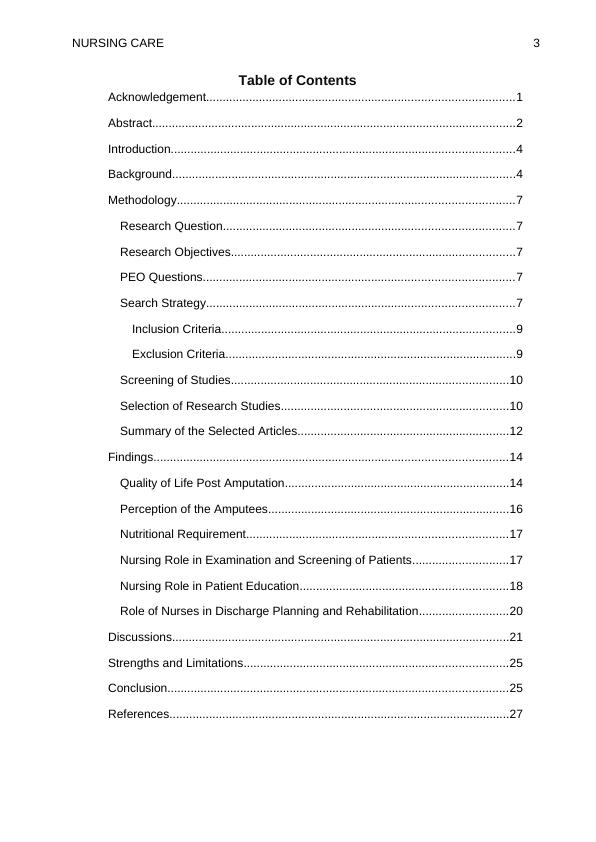
NURSING CARE 4
Introduction
Diabetes is one of the most severe non-communicable diseases that is
currently affecting the health of the global population. It has become an epidemic
disorder in most of the countries all across the globe (Unnikrishnan et al. 2017).
Several pieces of evidence suggest that its negative consequences are affecting the
health care service providers, along with the community the most (Nanditha et al.
2016). One of the several complications of diabetes includes diabetic foot ulcers and
infections. A foot ulcer is defined as a foot with a neurological disorder and vascular
involvement. It is prone to grave tissue damage and infection (Boulton 2020).
Treatment options for foot ulcers change contingent upon the seriousness of the
injury. In general, the treatment utilises techniques to evacuate dead tissue or trash,
keep the injury clean, and advance recuperating. Wounds should be checked much
of the time, no less than each one to about a month. At the point when the condition
brings about a severe loss of tissue or dangerous disease, an amputation might be
the main alternative (Heald et al. 2019).
The following sections of the paper will conduct an extended review of the
literature to analyse the perception of diabetic patients who have undergone leg-
amputation surgery and the different aspects of nursing care for such patients. The
paper will follow a comprehensive search protocol for the search of literature relevant
to the literature and select few papers to be reviewed using Caldwell critiquing tool
and then analyse the content of the selected articles to develop a comprehensive
discussion on the nursing care for diabetic patients who have recently undergone leg
amputation.
Introduction
Diabetes is one of the most severe non-communicable diseases that is
currently affecting the health of the global population. It has become an epidemic
disorder in most of the countries all across the globe (Unnikrishnan et al. 2017).
Several pieces of evidence suggest that its negative consequences are affecting the
health care service providers, along with the community the most (Nanditha et al.
2016). One of the several complications of diabetes includes diabetic foot ulcers and
infections. A foot ulcer is defined as a foot with a neurological disorder and vascular
involvement. It is prone to grave tissue damage and infection (Boulton 2020).
Treatment options for foot ulcers change contingent upon the seriousness of the
injury. In general, the treatment utilises techniques to evacuate dead tissue or trash,
keep the injury clean, and advance recuperating. Wounds should be checked much
of the time, no less than each one to about a month. At the point when the condition
brings about a severe loss of tissue or dangerous disease, an amputation might be
the main alternative (Heald et al. 2019).
The following sections of the paper will conduct an extended review of the
literature to analyse the perception of diabetic patients who have undergone leg-
amputation surgery and the different aspects of nursing care for such patients. The
paper will follow a comprehensive search protocol for the search of literature relevant
to the literature and select few papers to be reviewed using Caldwell critiquing tool
and then analyse the content of the selected articles to develop a comprehensive
discussion on the nursing care for diabetic patients who have recently undergone leg
amputation.
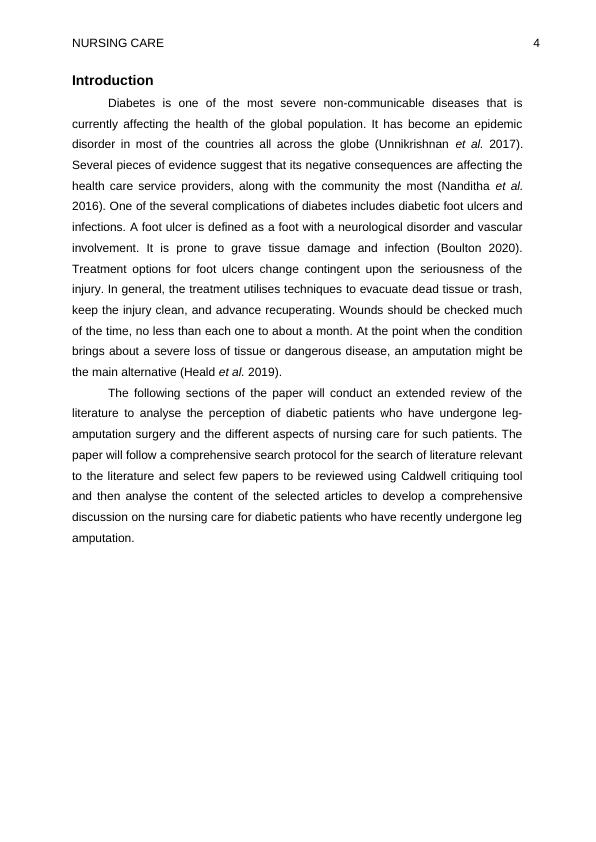
NURSING CARE 5
Background
As indicated by the report of the World Health Organization (WHO), the
number of diabetic patients in 2000 came to 171 million. It was anticipated to
increment 380 million by 2025 (Roglic 2016). Tackling the issue worried about the
worldwide increment in the number of diabetes frequencies and its inconveniences
requires a close joint effort among wellbeing framework and individuals; create
national and global systems and communication with other wellbeing colleagues. By
this methodology, giving adequate and viable wellbeing, administrations are
essential for patients and their families (Ogurtsova et al. 2017). Also, improving the
nature of medical attendants' clinical presentation can prompt changes in customer
and patient social orders.
Among diabetes' confusions, various sorts of foot issues, for example, ulcers
and diseases are standard, and it has indicated an expanding pattern in the previous
decade (Santema et al. 2018). Diabetic foot is characterised by WHO as a foot in
people with diabetes with neurologic disarranges, some level of vascular inclusion
with or without metabolic complexities of diabetes in lower limit and inclined to
disease, scarring, with or without profound tissue harm. A few examinations have
demonstrated that 15 per cent of diabetic patients will be experiencing diabetic foot
ulcer during their lifetime (Paisey et al. 2019). A diabetic foot ulcer is the broadest
reason for hospitalisation in diabetic patients. Then again, these ulcers can prompt
contamination, gangrene, amputation and even demise if the fundamental
consideration is not given.
Moreover, lower limb amputation is related to delayed hospitalisation and
recovery. Furthermore, it is required for home consideration and social help. In
general, the pace of lower appendage amputation in diabetic patients is 10–30 times
higher than non-diabetics (Paisey et al. 2019). In the initial two years after
amputation, there is a 50 per cent danger of re-amputation, and three years after
lower appendage amputation, half of the patients might be dead.
Over 60% of diabetic foot ulcers are the consequence of hidden neuropathy
(Azzopardi et al. 2018). The more usually depicted systems of activity are the polyol
pathway. The hyperglycaemic state prompts an expansion in real life of the
chemicals aldose reductase and sorbitol dehydrogenase—these outcomes in the
change of intracellular glucose to sorbitol and fructose. The gathering of these sugar
Background
As indicated by the report of the World Health Organization (WHO), the
number of diabetic patients in 2000 came to 171 million. It was anticipated to
increment 380 million by 2025 (Roglic 2016). Tackling the issue worried about the
worldwide increment in the number of diabetes frequencies and its inconveniences
requires a close joint effort among wellbeing framework and individuals; create
national and global systems and communication with other wellbeing colleagues. By
this methodology, giving adequate and viable wellbeing, administrations are
essential for patients and their families (Ogurtsova et al. 2017). Also, improving the
nature of medical attendants' clinical presentation can prompt changes in customer
and patient social orders.
Among diabetes' confusions, various sorts of foot issues, for example, ulcers
and diseases are standard, and it has indicated an expanding pattern in the previous
decade (Santema et al. 2018). Diabetic foot is characterised by WHO as a foot in
people with diabetes with neurologic disarranges, some level of vascular inclusion
with or without metabolic complexities of diabetes in lower limit and inclined to
disease, scarring, with or without profound tissue harm. A few examinations have
demonstrated that 15 per cent of diabetic patients will be experiencing diabetic foot
ulcer during their lifetime (Paisey et al. 2019). A diabetic foot ulcer is the broadest
reason for hospitalisation in diabetic patients. Then again, these ulcers can prompt
contamination, gangrene, amputation and even demise if the fundamental
consideration is not given.
Moreover, lower limb amputation is related to delayed hospitalisation and
recovery. Furthermore, it is required for home consideration and social help. In
general, the pace of lower appendage amputation in diabetic patients is 10–30 times
higher than non-diabetics (Paisey et al. 2019). In the initial two years after
amputation, there is a 50 per cent danger of re-amputation, and three years after
lower appendage amputation, half of the patients might be dead.
Over 60% of diabetic foot ulcers are the consequence of hidden neuropathy
(Azzopardi et al. 2018). The more usually depicted systems of activity are the polyol
pathway. The hyperglycaemic state prompts an expansion in real life of the
chemicals aldose reductase and sorbitol dehydrogenase—these outcomes in the
change of intracellular glucose to sorbitol and fructose. The gathering of these sugar
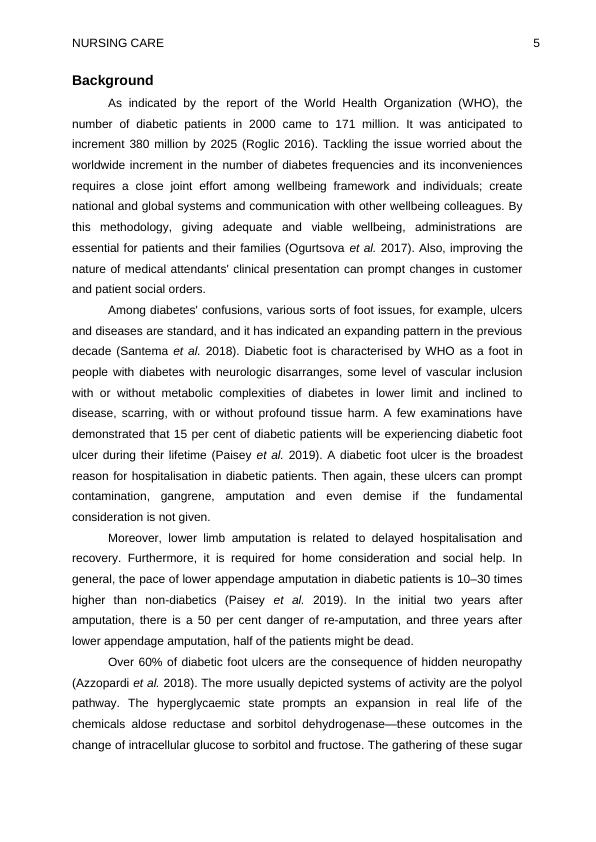
NURSING CARE 6
items brings about an abatement in the combination of nerve cell myoinositol,
required for normal neuron conduction (Ibrahim 2018).
Furthermore, the concoction transformation of glucose brings about the
exhaustion of nicotinamide adenine dinucleotide phosphate (NADP) stores, which
are fundamental for the detoxification of sensitive oxygen species (ROS) and the
combination of the vasodilator nitric oxide (NO) (Walton, Minton and Cook 2019).
There is a resultant increment in oxidative weight on the nerve cell and an expansion
in vasoconstriction prompting ischemia, which will advance nerve cell injury and
passing. Hyperglycemia and oxidative pressure likewise add to the anomalous
glycation of nerve cell proteins and actuation of protein kinase C, (PK-C) bringing
about further nerve brokenness and ischemia (Chen et al. 2019).
The improvement of diabetic foot ulcers results from a few components.
These components can expand the danger of foot ulcer and cause separation in the
skin or hindrance in the injury mending. Fringe neuropathy can cause excessive
weight on certain purposes of the feet. Therefore, ischemia can build the
helplessness to ulceration by impedance in fringe vascular. What is more important,
different factors, for example, poor vision, constrained joint development, lacking foot
inclusion, and shoes can be susceptive to ulceration in diabetics (Mathioudakis et al.
2017). The most significant point is that 85% of diabetic foot amputations are
preventable with due consideration and instruction (Mathioudakis et al. 2017).
Perfect administration for avoidance and treatment of diabetic foot is: the standard
impression of the foot, decide in danger foot, training to patient and wellbeing staff,
proper foot inclusion, and early treatment of foot issues. As per the convention
suggested by the American Diabetes Association (ADA), one of preventive strategy
in diabetes care is multidisciplinary group approach that its favourable circumstances
have appeared in a few investigations (Boyko 2018).
The individuals from group for diabetic foot care, as a rule, comprise of
general professional, nurture, teacher, orthotic, and podiatrists and a few advisors;
vascular specialist, contamination sickness pro, dermatologist, endocrinologist,
dietician, orthopaedic and it is fundamental the entrance to focuses and home
consideration administrations (Loke et al. 2018). Although all members have an
impact on a decrease, the occurrence of foot ulcer and amputation, the job of nurse
caretaker and podiatrists are basic and important.
items brings about an abatement in the combination of nerve cell myoinositol,
required for normal neuron conduction (Ibrahim 2018).
Furthermore, the concoction transformation of glucose brings about the
exhaustion of nicotinamide adenine dinucleotide phosphate (NADP) stores, which
are fundamental for the detoxification of sensitive oxygen species (ROS) and the
combination of the vasodilator nitric oxide (NO) (Walton, Minton and Cook 2019).
There is a resultant increment in oxidative weight on the nerve cell and an expansion
in vasoconstriction prompting ischemia, which will advance nerve cell injury and
passing. Hyperglycemia and oxidative pressure likewise add to the anomalous
glycation of nerve cell proteins and actuation of protein kinase C, (PK-C) bringing
about further nerve brokenness and ischemia (Chen et al. 2019).
The improvement of diabetic foot ulcers results from a few components.
These components can expand the danger of foot ulcer and cause separation in the
skin or hindrance in the injury mending. Fringe neuropathy can cause excessive
weight on certain purposes of the feet. Therefore, ischemia can build the
helplessness to ulceration by impedance in fringe vascular. What is more important,
different factors, for example, poor vision, constrained joint development, lacking foot
inclusion, and shoes can be susceptive to ulceration in diabetics (Mathioudakis et al.
2017). The most significant point is that 85% of diabetic foot amputations are
preventable with due consideration and instruction (Mathioudakis et al. 2017).
Perfect administration for avoidance and treatment of diabetic foot is: the standard
impression of the foot, decide in danger foot, training to patient and wellbeing staff,
proper foot inclusion, and early treatment of foot issues. As per the convention
suggested by the American Diabetes Association (ADA), one of preventive strategy
in diabetes care is multidisciplinary group approach that its favourable circumstances
have appeared in a few investigations (Boyko 2018).
The individuals from group for diabetic foot care, as a rule, comprise of
general professional, nurture, teacher, orthotic, and podiatrists and a few advisors;
vascular specialist, contamination sickness pro, dermatologist, endocrinologist,
dietician, orthopaedic and it is fundamental the entrance to focuses and home
consideration administrations (Loke et al. 2018). Although all members have an
impact on a decrease, the occurrence of foot ulcer and amputation, the job of nurse
caretaker and podiatrists are basic and important.
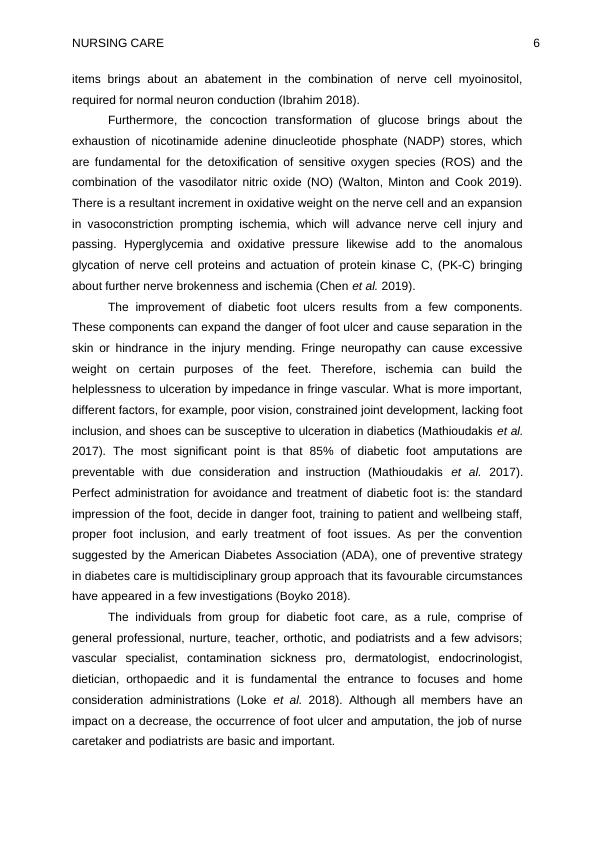
NURSING CARE 7
Existing examination on the experience of individuals with diabetes and foot
infection or potentially amputations is centred transcendently on understanding the
mental aspects of life post-amputation. Different examinations centre around
anticipation and care forms for diabetic foot ulceration and patients' observations and
information by self-care (Ribu et al. 2008). Significant elements examined in the
investigations remember the estimation of training for advising and planning people
for dangers related with diabetes, and life after amputation including the restoration
procedure; the significance of wellbeing experts in showing sympathy and
comprehension of patients' needs; and the centrality of thinking about individual
patient conditions in the arrangement of viable consideration and treatment (Briggs
2006). There is an absence of research on diabetic patients with active foot infection
as well as lower appendage amputations and their involvement in wellbeing
administrations explicitly. There is likewise an absence of information relating to
diabetes and foot care benefits in the global wellbeing framework, which is described
by the variety in the arrangement of diabetes administrations and qualification to free
medicinal services.
Methodology
Research Question
What is the perception of diabetic patients who have undergone leg
amputation recently?
What are the major nursing care aspects requirement for management
of a diabetic patient who has undergone leg amputation surgery
recently?
Research Objectives
To explore the perception of patients with diabetes who had diabetic
foot ulcer and have undergone leg amputation surgery.
To study the different aspects of nursing care and management of
diabetic patients who have undergone leg amputation surgery in the
recent past.
PEO Questions
The research question was framed according to the Population, Exposure &
Outcome structure. The key population for the study is the patients who are suffering
from diabetes and are at risk of developing a diabetic foot ulcer. The exposure for
Existing examination on the experience of individuals with diabetes and foot
infection or potentially amputations is centred transcendently on understanding the
mental aspects of life post-amputation. Different examinations centre around
anticipation and care forms for diabetic foot ulceration and patients' observations and
information by self-care (Ribu et al. 2008). Significant elements examined in the
investigations remember the estimation of training for advising and planning people
for dangers related with diabetes, and life after amputation including the restoration
procedure; the significance of wellbeing experts in showing sympathy and
comprehension of patients' needs; and the centrality of thinking about individual
patient conditions in the arrangement of viable consideration and treatment (Briggs
2006). There is an absence of research on diabetic patients with active foot infection
as well as lower appendage amputations and their involvement in wellbeing
administrations explicitly. There is likewise an absence of information relating to
diabetes and foot care benefits in the global wellbeing framework, which is described
by the variety in the arrangement of diabetes administrations and qualification to free
medicinal services.
Methodology
Research Question
What is the perception of diabetic patients who have undergone leg
amputation recently?
What are the major nursing care aspects requirement for management
of a diabetic patient who has undergone leg amputation surgery
recently?
Research Objectives
To explore the perception of patients with diabetes who had diabetic
foot ulcer and have undergone leg amputation surgery.
To study the different aspects of nursing care and management of
diabetic patients who have undergone leg amputation surgery in the
recent past.
PEO Questions
The research question was framed according to the Population, Exposure &
Outcome structure. The key population for the study is the patients who are suffering
from diabetes and are at risk of developing a diabetic foot ulcer. The exposure for
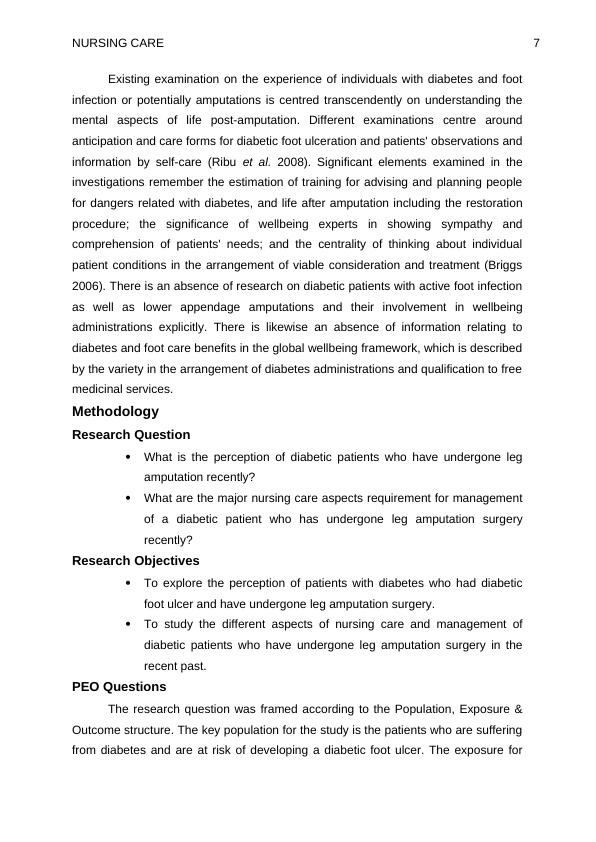
End of preview
Want to access all the pages? Upload your documents or become a member.
Related Documents
Principles of Nursing: Surgicallg...
|11
|2904
|102
Management of Diabetic Foot Ulcers: Best Practices for Care Professionalslg...
|8
|2302
|202
Pathophysiology, Nursing Priorities and Management of Diabetic Foot Ulcer: A Case Studylg...
|10
|2726
|139
Evidenced-Based Research on Maggot Debridement Therapylg...
|12
|3058
|119
Nursing Management of Diabetic Footlg...
|15
|3210
|79
Introduction to Wound Management (CNA507)lg...
|20
|4935
|259
